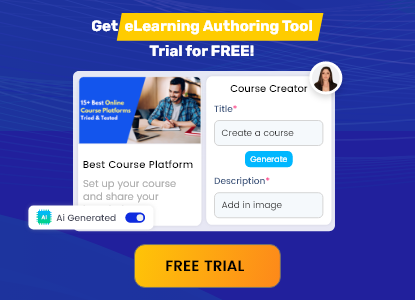In today’s fast-paced digital world, learning has evolved far beyond textbooks and traditional classrooms. With increasing attention spans shrinking and the demand for engaging, interactive education growing—video-based learning has emerged as one of the most effective, future-ready learning strategies. Whether you’re a corporate trainer, educator, or a learning and development (L&D) professional, understanding what video-based learning is and how to implement it effectively can give your training strategy a serious upgrade.
In this blog, we’ll explore what video-based learning is, its benefits, its growing role in the future of education, and how tools like authoring software can help you create powerful learning videos. Let’s dive in.
What Is Video-Based Learning?
Video-based learning is a modern instructional approach that uses video content as the primary medium for delivering knowledge and training. It can include a wide range of formats—tutorials, explainer videos, interactive videos, scenario-based storytelling, and simulations. The aim is to improve learner engagement, knowledge retention, and accessibility.
Video-based learning isn’t just about watching a video—it’s about learning through videos. When integrated with interactive elements, quizzes, and real-world scenarios, it becomes a highly immersive experience that resonates with today’s visual learners.
Why Is Video-Based Learning So Effective?
Video appeals to multiple senses. It combines audio, visuals, text, and motion, enabling learners to process and retain information more effectively. Here’s why video-based learning works:
- Enhanced Engagement: Learners are 75% more likely to watch a video than read a document.
- Improved Retention: Studies show people retain 95% of a message when they watch it in a video, compared to only 10% when reading it in text.
- Flexibility & Accessibility: Learners can access video content anytime, anywhere, on any device.
- Microlearning Friendly: Short, focused video lessons match the fast-paced lives of today’s learners.
How Is Video-Based Learning Shaping the Future of Education?
The future of learning is deeply visual and learner-centric. Here’s how video-based learning is transforming education and corporate training:
1. Personalized Learning Paths
Videos can be tailored to individual learning styles and paces. AI-based learning platforms can recommend specific video content based on a learner’s progress and performance.
Personalized video playlists help reduce learner fatigue and ensure each individual gets exactly the support they need. This adaptive approach enhances motivation, satisfaction, and long-term retention.
2. Interactive Learning Experiences
Interactive videos with branching scenarios, clickable content, and in-video quizzes increase learner participation and decision-making skills.
These elements transform passive viewing into active learning, promoting critical thinking and real-world application. Learners are more likely to stay engaged and complete courses when interaction is embedded throughout the content.
3. Scalable Training Solutions
4. Remote & Hybrid Learning Ready
In the post-pandemic era, video-based learning ensures continuity of education and training regardless of physical location.
It supports learners across time zones, enabling asynchronous learning that fits their schedule. With cloud access and mobile optimization, learners can view content anytime, anywhere—even offline in some cases.
How Can Authoring Tools Help You Create Video-Based Learning?
To build impactful video-based courses, using a video-based learning authoring tool is essential. These tools help you create, edit, and publish learning videos efficiently. Here’s how:
Drag-and-Drop Editing
Authoring tools like CogniSpark AI, Articulate Storyline, Adobe Captivate, and Vyond allow easy video creation with drag-and-drop interfaces and animation libraries.
Interactive Features
Add quizzes, simulations, hotspots, and decision points to make your video content more engaging.
Multi-device Responsiveness
Ensure your videos work seamlessly across devices—mobile, tablet, or desktop.
SCORM/xAPI Compatibility
Ensure your videos work seamlessly across devices—mobile, tablet, or desktop.
Looking to explore authoring tools? Explore 24 Best eLearning Authoring tools
When Should You Use Video-Based Learning?
- Corporate onboarding & compliance training
- K-12 and higher education content
- Sales enablement and product training
- Healthcare simulations
- Software and technical skill training
Pro Tip: Combine video-based learning with gamification or assessments for higher engagement and outcomes.
Ready to Transform Your Training with Video-Based Learning?
Video-based learning isn’t just a trend—it’s the future of education. Whether you’re a corporate L&D leader, an instructional designer, or an educator, it’s time to start integrating video into your learning strategy.
Need help designing your video learning course? Contact us and see how we can bring your vision to life!
About the author
Olivia Dodd
author
Olivia Dodd is an eLearning strategist at CogniSpark AI, bringing her expertise in operations, performance optimization, and inclusive learning solutions. With a strong background in business development and workforce transformation, she focuses on creating engaging and effective eLearning experiences for organizations worldwide. At CogniSpark AI, Olivia plays a key role in developing innovative learning strategies that align with corporate goals, ensuring seamless integration of technology and instructional design. Her passion for diversity, equity, and inclusion also drives her efforts to build learning solutions that are accessible and impactful for all learners. With years of experience in leadership roles, Olivia has successfully collaborated with global enterprises, enhancing their training programs through cutting-edge eLearning solutions.





















